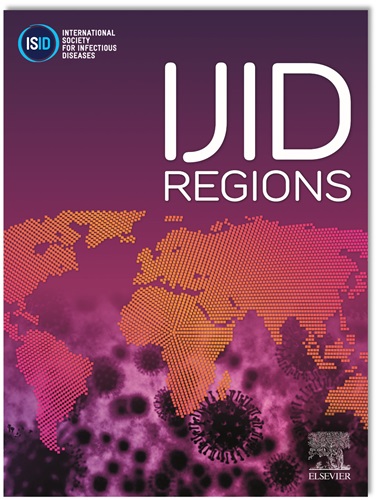东南亚和撒哈拉以南非洲新生儿麻疹免疫球蛋白 G 抗体的血清流行病学:一项观察性多中心研究。
IF 4.3
2区 医学
Q1 INFECTIOUS DISEASES
引用次数: 0
摘要
目的:调查孟加拉国、不丹、印度、埃塞俄比亚、莫桑比克、肯尼亚、尼日利亚、马里和南非新生儿经胎盘获得麻疹IgG的情况。方法:采用商用酶联免疫吸附法(ELISA)检测B组链球菌多中心研究存档的脐带血血清中麻疹IgG的含量。我们从每个地点随机抽取了323个样本进行测试。利用各种麻疹抗体衰减率的模型在婴儿期进行了探索。结果:共分析脐带血血清2907份。出生时,49.9%的新生儿麻疹IgG血清阴性。麻疹血清阴性从尼日利亚的21.7%到不丹的73.4%不等。实施麻疹疫苗接种后母亲所生婴儿血清阴性的调整后几率是未接种疫苗母亲所生婴儿的1.78倍(aOR, 1.78;95%置信区间:1.43—-2.21;结论:我们的研究结果表明,新生儿经胎盘获得的麻疹IgG较低,这可能在很小的时候就对麻疹感染产生易感性。目前在低收入和中等收入国家推荐的麻疹疫苗接种方案,建议从9个月及以后接种第一剂,值得重新考虑,包括需要更早的给药方案。本文章由计算机程序翻译,如有差异,请以英文原文为准。
Sero-epidemiology of measles immunoglobulin G antibodies among newborns from South-East Asia and sub-Saharan Africa: an observational, multicenter study
Objectives
To investigate the transplacental acquisition of measles immunoglobulin (Ig)G in newborns at delivery in Bangladesh, Bhutan, India, Ethiopia, Mozambique, Kenya, Nigeria, Mali, and South Africa.
Methods
Archived cord serum, from a multicenter study on Group B Streptococcus, were tested for measles IgG using a commercial enzyme link immunosorbent assay (ELISA). We tested 323 randomly selected samples from each of the sites. Models using various measles antibody decay rates in infancy were explored.
Results
Overall, 2,907 cord serum samples were analyzed. At birth, 49.9% of newborns were measles IgG seronegative. Measles seronegativity ranged from 21.7% in Nigeria to 73.4% in Bhutan. The adjusted odds of seronegativity in infants of mothers born after measles vaccination implementation was 1.78 times that for infants born to unvaccinated mothers (adjusted odds ratio 1.78; 95% confidence interval 1.43-2.21; P <0.001). Modeling measles-IgG kinetics predicted that 70.8%, 88.3%, and 100% of infants would be seronegative by 2, 4, and 6 months, respectively, without further exposure.
Conclusions
Our findings suggest low transplacental acquisition of measles IgG in newborns, which is likely to yield susceptibility to measles infection at a very young age. The currently recommended measles vaccine schedules in low- and middle-income countries (LMICs), with the first dose recommended from 9 months of age and onward, warrant reconsideration, including the need for earlier dosing schedules.
求助全文
通过发布文献求助,成功后即可免费获取论文全文。
去求助
来源期刊
CiteScore
18.90
自引率
2.40%
发文量
1020
审稿时长
30 days
期刊介绍:
International Journal of Infectious Diseases (IJID)
Publisher: International Society for Infectious Diseases
Publication Frequency: Monthly
Type: Peer-reviewed, Open Access
Scope:
Publishes original clinical and laboratory-based research.
Reports clinical trials, reviews, and some case reports.
Focuses on epidemiology, clinical diagnosis, treatment, and control of infectious diseases.
Emphasizes diseases common in under-resourced countries.

 求助内容:
求助内容: 应助结果提醒方式:
应助结果提醒方式:


